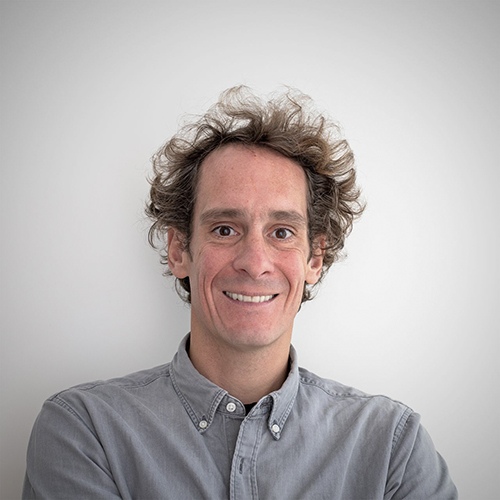
Submerged Excellence: Andy Schmid's Award-Winning Underwater Photography at the 2024 World Nature Photography Awards
The depths of the ocean are a canvas for a select group of artists, and Andy Schmid is a standout among them, capturing the elusive creatures of the deep with remarkable skill. His recent victory in the Underwater Category at the 2024 World Nature Photography Awards, highlighted by an evocative image of a female orca, has captured the admiration of both the public and critics alike. Schmid’s reflection on the moment he reviewed his shots on land reveals a combination of fortune and skill that characterizes the elite in photography. In the challenging conditions of underwater photography—from the murky fjords of Northern Norway to the biting cold that tests even the hardened—Schmid has cultivated a profound bond with the marine world.
Within this realm, the intricate feeding dance of the orcas becomes his canvas, a behavior he seeks to anticipate and immortalize through years of dedicated practice. His journey is one of relentless dedication, marked by the thrill of capturing the perfect image and the quiet expectancy of the orcas’ subsequent actions. Schmid’s transition from an enthusiastic diver to a masterful visual storyteller unfolds as he explores both the orca’s habitat and his personal evolution in photography.
Andy Schmid’s work goes beyond merely documenting the transient beauty of marine life; it underscores our deep connection to the natural world. His photographs act as a conduit between the oceanic depths and the public, underscoring the critical need to protect our marine environments. Join us as we delve into Andy Schmid’s unique photographic odyssey and celebrate his significant contributions to the art and science of photography.
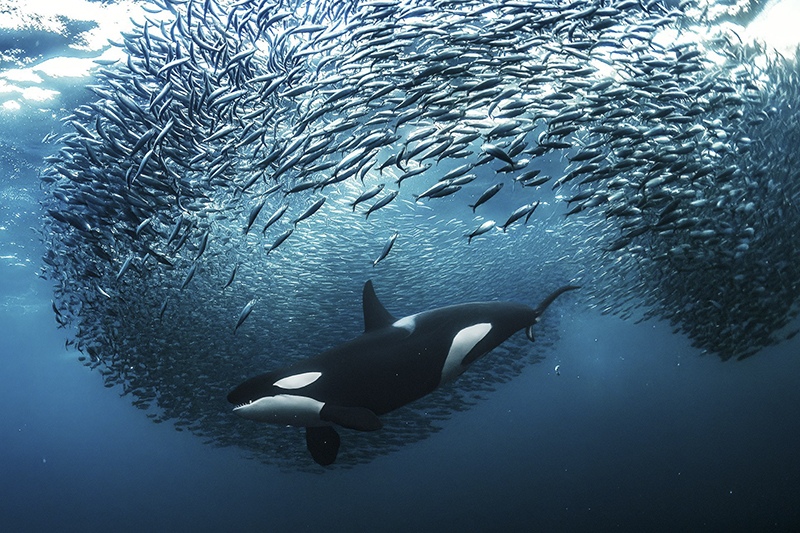
Congratulations on winning the 2024 World Nature Photography Awards, Underwater Category. Can you tell us about the moment you realized you captured the award-winning shot of the female orca?
A: Everything happens very fast in situations like this and there’s hardly any time to review the shots and reflect while out at sea. I knew the situations on that day were very special and so I was quite confident that I had some good shots. However it was only later that day when I got back to land and downloaded the photos from the camera that I saw what I had and realized how good it was and that it had great potential for competitions and publications.
Your description of the herring bait ball event paints a picture of an almost otherworldly scene. How do you prepare mentally and physically for such a demanding freediving photography session?
A: Underwater photography is very hard to plan and is a mix of dedication, perseverance, patience, experience, skill and luck, especially when it comes to open ocean pelagic life photography. The countless unsuccessful attempts are what prepare you to be ready when the opportunity is there. Since everything happens so fast one must be able to adapt to the conditions instantly. Camera settings, positioning in the water and swimming hard are super important. To get myself in the right spot I rely on my fitness. Endurance and powerful fin kicks are very important and for that I run regularly when I’m not in the field. Some freediving training would be beneficial too, of course but I have to admit that I don’t do enough in that area.
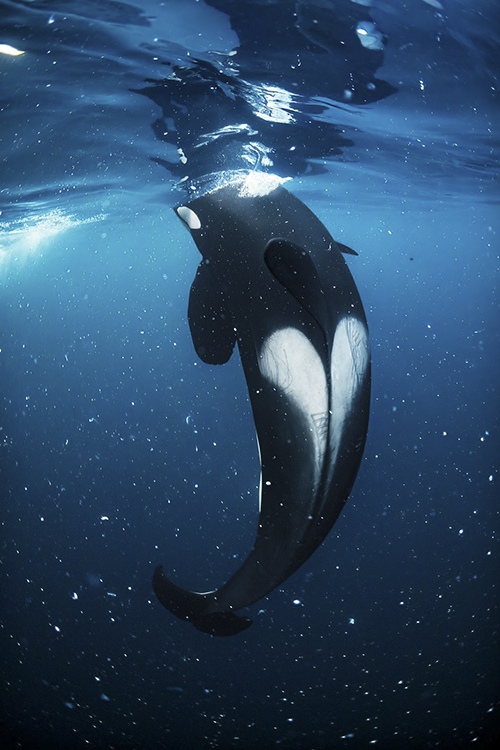
The carousel feeding technique of orcas is a sophisticated hunting strategy. What challenges did you face in capturing this behavior, and how did you overcome them?
A: It’s all about timing. I have experienced bait ball situations with feeding orcas dozens of times but so often when I made it there it was already over or they pushed the herring so hard that I could not keep up with them. It’s the sum of attempts that eventually got me there. Knowing what to look for, understanding how to read the different signs underwater, anticipating what will happen next, where to be and adapting accordingly. Without many unsuccessful attempts I would most likely not have been able to execute on the perfect encounters.
You mention the limited light and visibility in the fjords of Northern Norway. What techniques and equipment do you use to capture such clear images under these conditions?
A: I shoot a Canon EOS 5D Mk IV DSLR camera that is known to be quite powerful in low light conditions. The conditions require quite high ISO settings in order to get a good enough exposure which is the biggest pain point in these waters. Only on rare occasions where everything comes together can you have a day where you can shoot ISO ranges of 500-1000 which will result in relatively little noise. Most often values of 2000 ISO and above are required to get results in these waters which is why so many shots out there are very noisy. Denoising software has improved greatly over the past few years but a really noisy photo will still not turn out great at the moment.
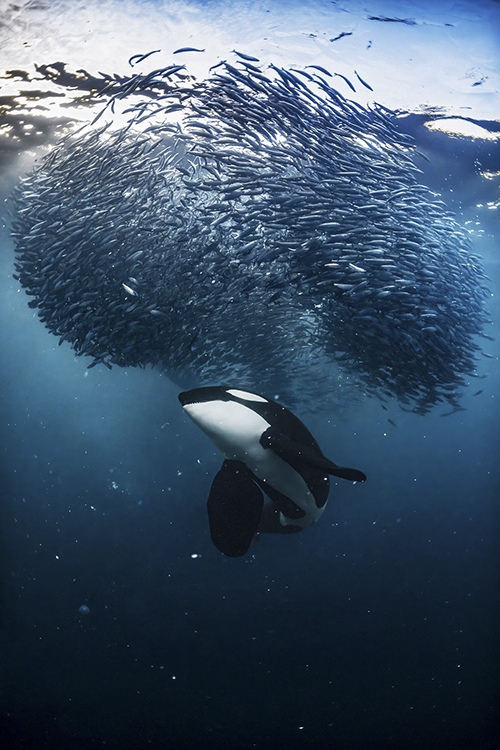
Freezing temperatures can be a deterrent for many photographers. What drives you to brave these extreme conditions for the perfect shot?
A: I’m Swiss and have spent countless days in the mountains in the winter skiing and snowboarding ever since I was a kid. I guess I am kind of used to cold conditions based on that. On top comes that if I really enjoy something as much as I do observing the whales in Norway, I am willing to take a beating, no matter if it means ice cold conditions, snow storms out at sea or just rough seas. The joy of witnessing the beauty and rawness of nature kills all the pain.
Could you walk us through the process you followed to track and photograph the orcas during their feeding frenzy?
A: In a perfect bait ball situation like it was when I took my winning photo, the bait ball is kind of static, meaning not moving much. What usually happens is that the orcas are taking turns in order to keep the bait ball right at the surface. For this to happen a few of them will constantly position themselves underneath the bait ball, turning upside down in order to show their white bellies to the herring which will scare them and push them towards the surface. Meanwhile other orcas will feed and therefore constantly turn away from the bait ball, approach it again and attack it by using a variety of techniques. I try to read their movements by seeing what’s happening both under and above water (when further away it’s not possible to see the orcas underwater yet but their fins can be seen approaching above water when surfacing for breaths). Based on this I dive, trying to be in the right spot when an orca reaches the bait ball. Of course there is a lot of trial and error involved. No idea how many times that I’ve dived and waited until I had to resurface for a breath while nothing had happened, just to see an orca hit the bait ball right when I got back to the surface.
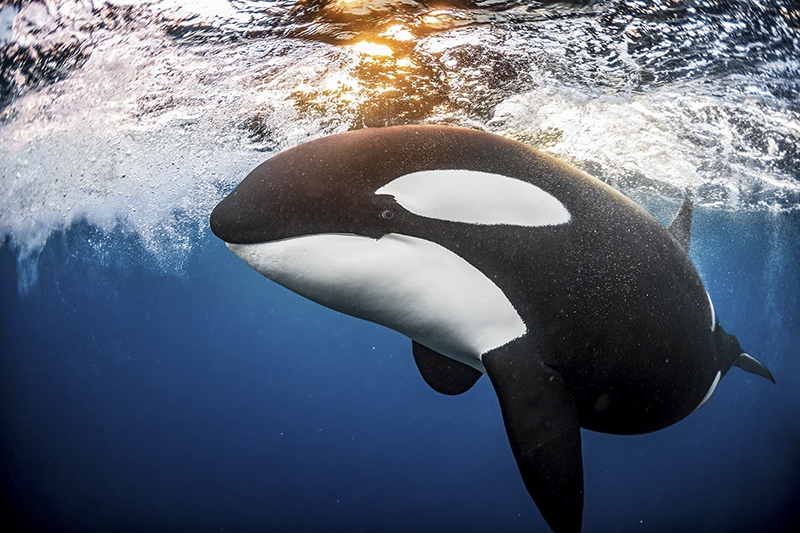
Your experience with these orcas must have been intense. Was there a particular moment or interaction that stood out to you during your dives?
A: I’ve now been to Norway for 6 consecutive years and there are so many unforgettable experiences but the most outstanding encounter must have been one that I had last season when a male was just sitting a few meters below the surface without moving as I approached. He must not have noticed me at all as he suddenly started swimming backwards (I did not know they could do that until I saw it) and approached me, his fluke coming right at me. As I moved out of his way he slowly swam right past me within touching distance and then suddenly stopped as he saw me. It felt like he was equally interested as he checked me out for an instance, then kept reversing further, turned around and swam off. I was all by myself. This was one of the purest, rawest, most powerful moments I’ve ever had and felt. Me, tiny little human in front of the most powerful hunter. Something that would not be possible with land predators.
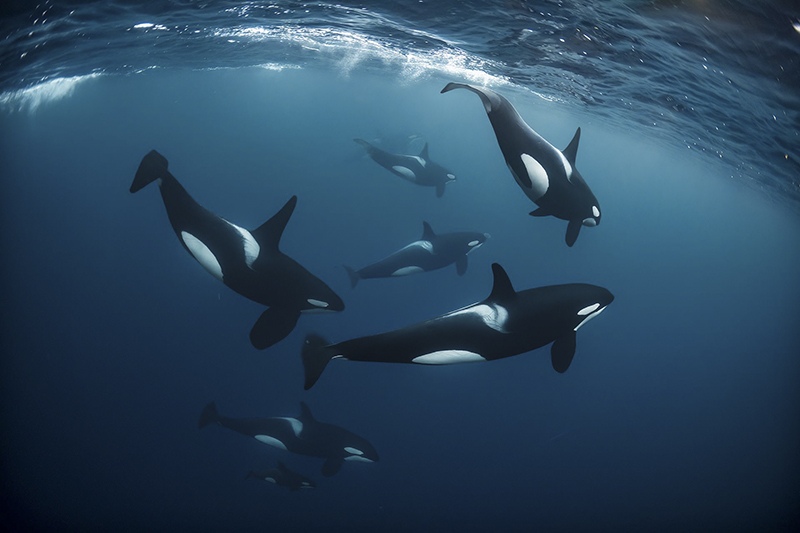
In terms of conservation, what do you hope your photographs will communicate or achieve regarding marine life and their ecosystems?
A: With my photography, I focus on showing the beauty and complexity of wildlife and their ecosystems. And by doing that I try to raise awareness regarding the impacts that we have as humans. However I also believe that imagery often needs more context and therefore I write articles whenever I get an opportunity or try to support articles and publications with my imagery. Take orcas in Norway for example. Herring, which they feed on for most of the year by following their migration route, are being fished by humans. While there are regulations in place regarding how much can be fished, these regulations are made by humans to ensure that the stock doesn’t collapse in order to further harvest on an annual basis. Is this in line with what the orcas need (and humpback plus fin whales who rely on them as a food source as well)? Most likely not. Fisheries use so much technology to identify fishing grounds and can rely on machines to put them in the right place. For whales, having their food sources reduced means harder search for food, more swimming to find something to eat and eventually, in a worst case, starvation and death. The more people that care and understand these connections, the more they move away from consuming fish. That is if they don’t rely on fish as a food source, of course, which applies to anyone that is not living in a coastal area. If the fish consumption in all non-coastal areas collapsed, the pressure on marine life would be drastically reduced. Assuming that the majority of readers is not living in a coastal area, I would like you to consider not eating anything that comes from the ocean unless you are at the ocean and eat what has been locally fished in a sustainable way.
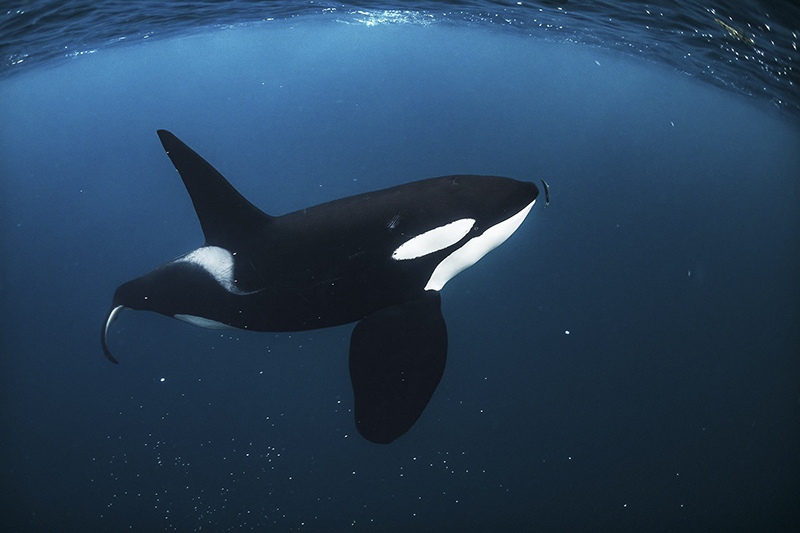
Can you share a bit about your journey in nature photography and how you came to specialize in underwater photography?
A: My photography journey started when I started diving in 2003. For the first few years my focus was lying only on diving and learning how to become a better diver. I reached a professional diving degree before I started focussing on marine life and photography which was in 2009 when I picked up my first decent camera. Still a point-and-shoot back then, I learned by doing as I progressed, continuously upgrading my camera setup with external light sources, additional lenses, then a better camera, more lights and so on. In early 2018 I bought the setup that I’m still using today. Initially when I started taking pictures underwater, it was just to show what I was seeing down there to my friends and family. It evolved through the years, especially when I realized that what I created was of interest to a much broader audience.
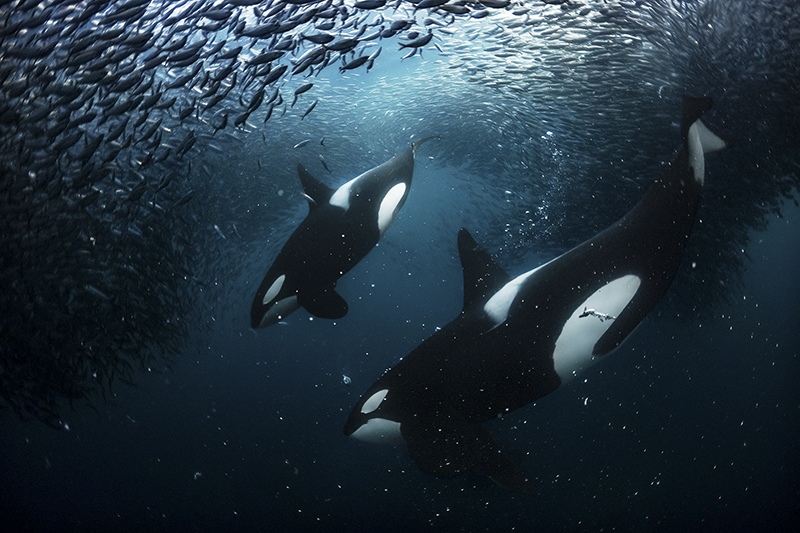
Having captured such extraordinary images, what advice would you give to aspiring nature photographers who want to dive into underwater photography?
A: Be patient and expect unsuccessful trips/expeditions along the way. Learn from these experiences and become better in order to be prepared and ready when great opportunities arise.
Looking ahead, do you have any specific projects or subjects in underwater photography that you’re particularly interested in pursuing, and what motivates your choice for these future endeavors?
A: I’ve wanted to go to Mexico during the winter months to experience and capture the sardine migration with hunting marlins for many years but it always collided with my Norway expeditions. Maybe this year is the year as I’m currently not certain whether I will be back in Norway or not.
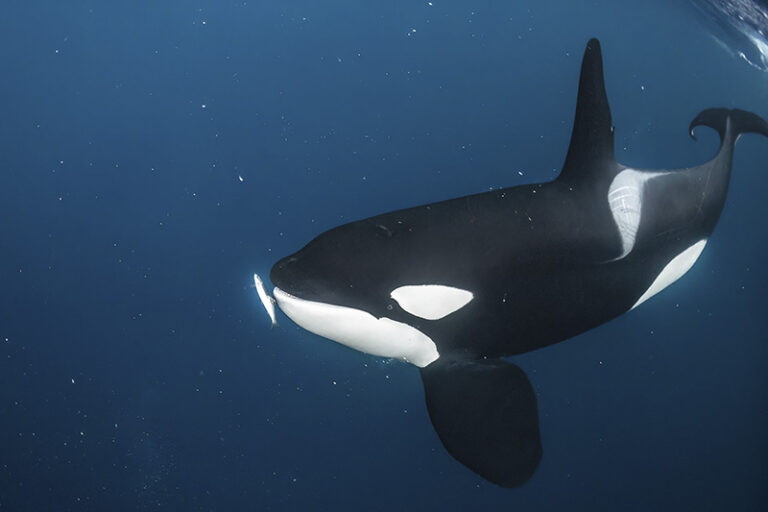
Andy Schmid’s photography goes beyond mere visual beauty, serving as a vital call for marine conservation. His compelling images highlight the urgent need to protect our oceanic ecosystems, reminding us that each photograph is not just a capture, but a call to action for future preservation.